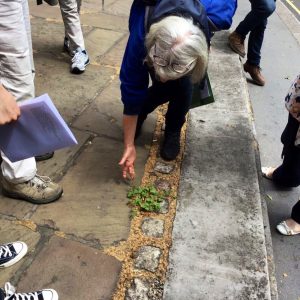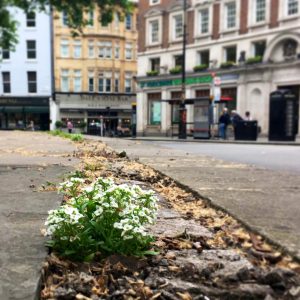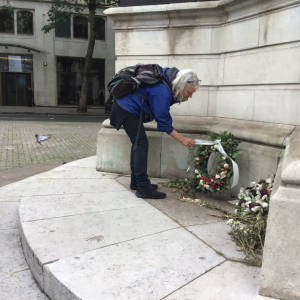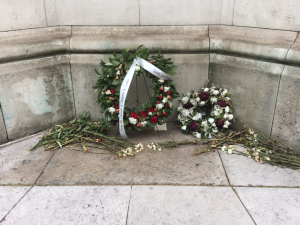Turn around and face St Clement Danes. Walk to the right of the Church, along the narrow footway. Along the side of the church, be careful where you tread, and keep your eyes peeled for little shoots of greenery! Or click here to go back to Stop 2: Clearing St Clements.
By Clare Brant

Admiring the geraniums at St Clement Danes, London History Day, 30 May 2019.
On the south side of the paved frontage of St Clements is a raised curve next to the road. Along it, at curiously regular intervals for wild flower self-sowings, are some wild geraniums, or Bloody Cranesbill.
Geranium sanguineum is found around Britain and especially at coasts, where broken seashells supply the alkaline soil it likes. But the same limestone element is found in city pavements, so it can thrive in London.
Geranium, the genus name, comes from the Greek for crane (geranos), describing the beaky seed capsule; sanguineum comes from the Latin word for blood (which also gives us sanguine). Although the principle of sympathetic magic meant the leaves especially were used to stem blood, the plant’s 'bloodiness' alludes to the red colour of its stalks and seeds.

Lobelia at St Clement Danes, London History Day, 30 May 2019.
The cranesbills have been joined by some definitely cultivated and deliberately planted lobelia.
Lobelia too has an eloquent name: it commemorates the Flemish botanist Matthias de ‘Obel or Lobel (1538-1616). The botanist commemorating his colleague was Charles Plumier – we’ll meet him again!
Walk back towards Australia House. Directly infront of St Clements' front doors, facing toward Australia House, is a monument to William Gladstone. Gladstone served for 12 years as Prime Minister of the United Kingdom from 1868 to 1894. Move around to the front of the monument, your back will be to Australia House once more.

The Gladstone monument, St Clements Courtyard. London History Day, 30 May 2019.
At the foot of Gladstone’s statue was a wreath from the Bulgarian Embassy: red roses, red and white carnations, laurel.
The reason? In April 1876, the Bulgarians rebelled against their Ottoman occupiers. The insurrection was put down with terrible violence. Intellectuals around Europe took up the Bulgarian cause. One was leading Liberal William Ewart Gladstone, then a member of the opposition.

Memorial flowers at the Gladstone monument, St Clements Courtyard. London History Day, 30 May 2019.
In September 1876 he published a rousing pamphlet, Bulgarian Horrors and the Question of the East. It sold 200,000 copies in a month. Attacking the Prime Minister Disraeli for not doing enough to help the Bulgarians, and fiercely denouncing Ottoman rule, Gladstone urged Europe to act.
Bulgaria was re-established as a nation in 1878. It is touching that Bulgaria still remembers and honours Gladstone for his support. Historian Roumen Genov says ‘In 1876 Todor Ikonomov, a renowned Bulgarian intellectual and politician, wrote that Gladstone had erected a monument in the heart of every aware Bulgarian with his intervention into the Eastern Crisis’.
Directions to Stop 4: Australia House (and a brief social history of... poop)
Use the traffic lights to cross Aldwych, and head toward Australia House. Once outside Australia House, go right. You're now on the curve of Aldwych. You will see a tree that is much smaller than all the others. Stop here.
